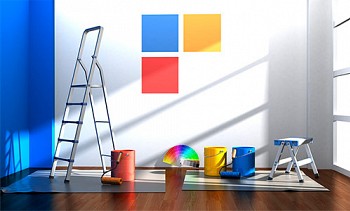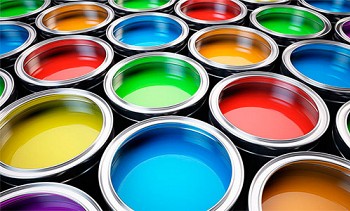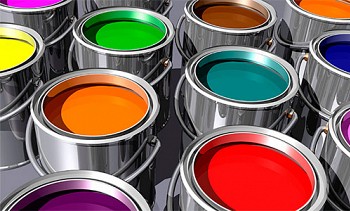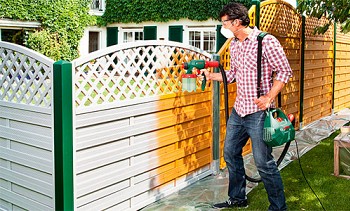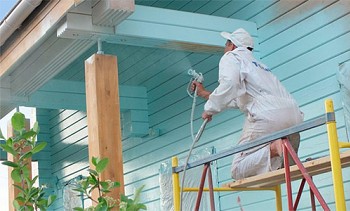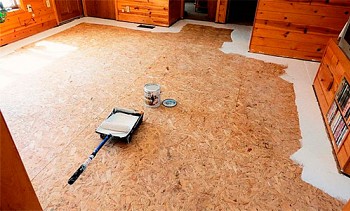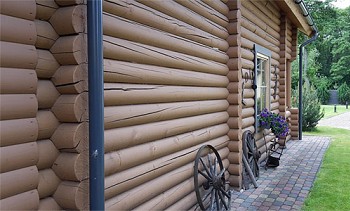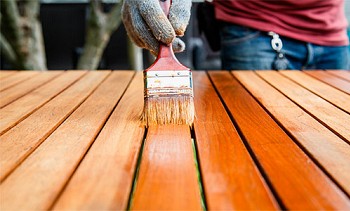Unlike walls and floors, ceilings are not forced by anything, their entire plane is open and the smallest speck or roughness of the surface is perfectly visible, especially with side light falling from a chandelier or other lighting device. In addition, the ceilings are always in the zone of elevated temperature, humidity and are a place of concentration of dust and other contaminants carried upward by convection currents.
Such operational features put forward special requirements to paints for a ceiling. Most interior paints are not adapted for this purpose and will bring nothing but difficulties in operation and further operation. LKM manufacturers of most brands highlight a special niche in the line for ceiling paints. But to say for sure which paint for the ceiling in the apartment is better is difficult - they usually differ only in some specific properties and for each specific case you need to choose your composition.
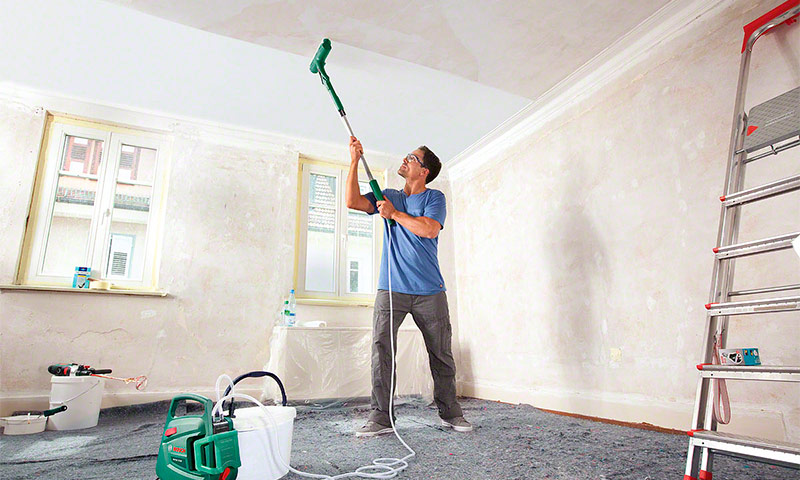
Content:
What types of paints are best for painting the ceiling in an apartment
To determine which ceiling paint is better, you can compare them in composition. Most often, paints of several chemical compositions are used:
- acrylic;
- latex;
- silicate;
- silicone.
In addition to the price, they are quite different in consumer properties, but, again, you can’t say which is better and which is worse - each of them has certain advantages in relation to a particular room and ceiling material.
Acrylic paints
The most popular type of water-soluble interior paints, which are most often used for painting the ceiling. They are based on acrylic resins, their copolymers and a number of other components. Acrylic compositions are produced in the form of emulsions and dispersions - the smallest particles of paint suspended in water. If you look under a microscope, emulsion paints look like tiny balls floating in water.
Acrylic resins do not dissolve in water and it is impossible to mix these liquids in any other way. Before use, acrylic paints must be thoroughly mixed so that the particles are evenly distributed throughout the volume. After painting the ceiling, the paint balls are rubbed over the entire plane, merge into a continuous film and form a thin, but sufficiently durable coating. After water evaporation, the paint polymerizes and does not interact with water anymore. Acrylic paints are quite flexible and do not crack and do not form blisters when the temperature in the room changes.

Latex paint
A modification of acrylic ceiling paints are latex. They are created on the same basis, but they contain artificial rubbers and other additives, which, after drying, form a very dense coating, characterized by high moisture resistance, but low vapor permeability.
Latex paints for ceilings are usually available in the form of white and snow-white compositions with different gloss levels, semi-gloss and semi-gloss are quite popular, they combine all the advantages of latex paints with the requirements for finishing ceilings. But glossy and deeply matt paints with latex content are also often used, especially on ceilings with complex relief. The fact is that rubber gives the coating layer a high degree of elasticity, it perfectly bends around any surface and forms a monolithic film on the decor of any complexity.
Latex paints for the most part are made on the basis of acrylic copolymers, so it’s cheaper without a noticeable loss in quality. But there are also compounds without acrylates, only on a rubber basis.But they are very expensive and are rarely used in mass construction and repair.

Silicate paint
The basis of such paints is liquid potassium glass emulsified in water, a suspension of talc, chalk, zinc white (base A) or calcium borate (base B). After drying, the paint forms a durable waterproof layer, characterized by high vapor permeability.
A limitation on the use of silicate paints is their insufficient strength on loose, highly porous, absorbent and polished surfaces. But on mineral substrates - plaster, concrete, brick, drywall, they are in some cases better than acrylic and latex, especially in wet rooms.
Silicate compositions are ideal for:
- kitchens;
- Bathrooms
- pantries;
- corridors;
- public places.
But in bedrooms and living rooms they are not recommended.
The disadvantage of silicate compositions is their low ductility - they do not cover microcracks and other base defects. But this drawback is balanced by dirt-repellent properties and high resistance to washing by almost any means. In addition, they actively inhibit the appearance of mold and fungus, eliminating the accumulation of moisture inside the ceilings. Even without the use of antiseptics, the risk of the appearance and reproduction of spores is minimal. Costs can also be added to the pluses - silicate paints are in the budget segment and are among the best in terms of price / quality ratio.

Silicone paints
When deciding what is better to paint the ceiling, silicone paints cannot be overlooked. They are created on the basis of silicone resins, but in their pure form are practically not used as paints for interiors. Manufacturers actively use their ability to mix with acrylic resins and offer compositions based on acrylates with a high percentage of silicones.
Such mixtures are highly practical and combine all the positive properties of silicate and acrylic compositions. They are durable, flexible, have high vapor permeability, waterproof. Also, x is characterized by high water resistance, elasticity and durability of the finish film. High adhesion to most mineral materials is complemented by excellent compatibility with old paints. They can be applied to both acrylic and silicate paints.

How to choose the color and texture of paint for the ceiling
Choosing paint for the ceiling, you can focus on their shine, water resistance, the ability to tint, cost. But it is best to choose the paint for its intended purpose - for the kitchen, living room, corridor, bathroom. Typically, manufacturers, recommending this or that type of paint for a certain room, have already taken into account the features of operation and introduced the necessary components in the paint to improve the properties.
Paint texture selection
In terms of gloss, there is a very wide variety of topcoat interior paints:
- glossy;
- semi-gloss;
- semi-matte;
- matte;
- deep matte.
They are almost identical in composition, except for the components responsible for the gloss of the surface. For the ceiling, it is best to choose paints, starting from a semi-matt level. They perfectly hide small defects in surface finish, tubercles, depressions, traces of tools. And glossy, on the contrary, emphasize all defects, shading them and making them more noticeable in reflected light.
But this does not mean that glossy paints for the ceiling are not suitable - in many cases they allow you to achieve interesting and useful optical effects, for example, visually increase the size of the room, make it brighter, emphasize interesting features of the architectural design of the house. In addition, usually, glossy paints are highly moisture resistant and very convenient when cleaning, allowing the use of active detergents.
Paint color selection
Traditional white ceilings do not go out of use, but it cannot be said that they continue to be at the peak of popularity.Variants of painting in pastel and bright colors of different saturation, and even multi-colored ceilings with combined colors, where white or not at all, or it is not predominant, began to occur more often.

But the choice of ceiling color is not at all arbitrary - there are certain rules by which paint should be chosen.
Most interior paints enter the market in the form of white bases of varying degrees of color saturation - white, bright white, snow white, dazzling white. As a rule, they are tinted in pastel colors or used without tinting. Another part of the colors is offered in colorless form - they are tinted in all tones, among which bright and saturated predominate. If you decide which color will prevail, then you should choose the right base - white color requires more pigment, so this paint will turn out to be more expensive.
Colors are tinted manually or on special machines with computer pigment selection. Often, the cost of tinting is comparable to the price of white paint for the ceiling, so calculate the repair budget based on this circumstance. But you can add color to the paint manually, before painting, however, it’s quite difficult to get into the shade. If a responsible ceiling in a design interior is painted, do not save on machine tinting.

Having chosen the paint of a particular manufacturer, try to buy pigments or color pastes from the catalog of the same brand. As a rule, they are developed for specific compositions and may not give the desired effect in a mixture with paints of a different origin. Also pay attention to what chemical composition the dye is intended for - pigments for silicone paints are not always suitable for acrylic and absolutely not suitable for silicate.

The main rule when choosing a color for the ceiling - it should be in harmony with the color of the walls, but not merge with them. If this happens, then the room immediately loses its shape and there is a feeling of unlimited space, which is not very acceptable in the interior of a residential building.
Designers recommend choosing the most comfortable tones for a certain type of room. Recommendations are not strict rules - each designer has his own approach to solving spatial problems, but the following colors are most appropriate:
1. For small rooms with a limited number of windows or without them (corridors, hallways) - blue, white, beige.

2. For the kitchen and dining room - the colors are not too bright shades. The paint is selected waterproof, vapor permeable.

3. Bedroom, living room - calm pastel colors, pure white in a semi-matte or matte sheen.

4. Childrens - bright cheerful colors.

5. Cabinets - white, cream, beige, in green or blue tones.
In no case should the ceiling be darker than the walls, although such trends are visible in the work of some designers. Even in bright light, such a room will create a feeling of heaviness above your head. It is best if the color gradually brightens from floor to ceiling, not merging, but not contrasting.
The degree of gloss has already been mentioned - matte and semi-gloss paints are most preferred in rooms with a normal ratio of height and area. Glossy and semi-glossy are appropriate in small rooms, rooms with a non-standard configuration and for solving various special design tasks.
The best paint for the ceiling - manufacturers overview
We repeat in the statement that it is difficult, almost impossible to choose the uniquely the best paint for all indicators. Each of them has its pluses and minuses, you can determine the best only by one or two indicators. For example, a paint that is excellent in hiding power and water resistance will turn out to be too “fragrant”, and environmentally friendly and vapor permeable poorly tinted. Therefore, we restrict ourselves to a brief overview of the best manufacturers, indicating the advantages of their paints.
Snowball
Paints of the Polish manufacturer "Sniezka" are practical, low price, ease of use. They are available in a wide variety of types and you can find the composition for concrete, drywall, wood, plaster.This allows one paint to cover the ceiling of dissimilar adjacent materials.
Paint "Snowball" was appreciated by both professionals and people who use it in household repairs. For the family budget, the better choice is the better to paint the ceiling, as there is practically no Snowball. The best paint for the ceiling - a series of "Disney", "Ultra Belle", "ECO".

Dulux
Professional paints of increased environmental safety. For ceilings, special compositions are very convenient, which when applied are pink in color, and after drying become perfectly white. This avoids unpainted spots against the background of a white primer or the first, already dried-out paint layer. Silver ions have been added to some formulations, eliminating the appearance of mold and fungus on the ceiling.
For paints, Dulux offers a wide selection of dyes from the Dulux Color Palette catalog. You can see how the ceiling will look under different lighting conditions with the help of special computer programs developed by the company.

Tikkurila
One of the most famous companies in the world of paints. Products of the Finnish concern belong to the LKM elite. You can choose paints for any materials that are tinted in the colors "Tikkurila Symphony" (20,000 colors), OPUS 1 (2436), Monicolor (2024) and several dozen other options. All paints are of the highest quality and, of course, quite a high price. As a rule, paints of the Finnish brand are used for design repairs in the design of exclusive interiors.

Tex
The budget paint of the Finnish concern Tikkurila. It is produced both in Finland and in Russia for widespread use, most often for household repairs. They do not require highly qualified builders, but the results from the use of TEKS are not too impressive. But at an affordable price for paint, updating the ceiling every 2 to 4 years is perfectly acceptable for any budget. Good colors in white and for tinting in rooms with a normal and dry microclimate. For kitchens, bathrooms, offices it is better to choose a paint more expensive.

Caparol
Given the current market situation, the Caparol brand is very confident, not inferior in popularity to Snowball and even surpassing it. But the price of this paint is significantly higher. The German brand Caparol produces environmentally friendly interior paints for various purposes. Latex and silicone compounds of the CAPASILAN, Indeko-Plus, Samtex and others series are designed for ceilings. They are excellently tinted according to the ColorExspress system and are distinguished by their durability and exceptional color fastness.


